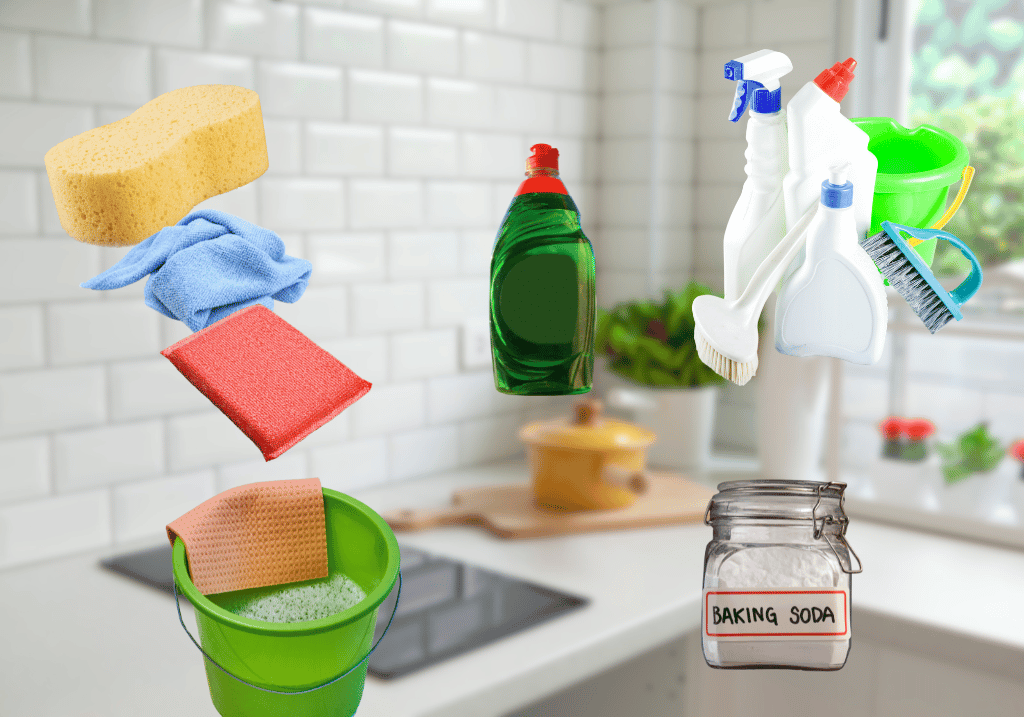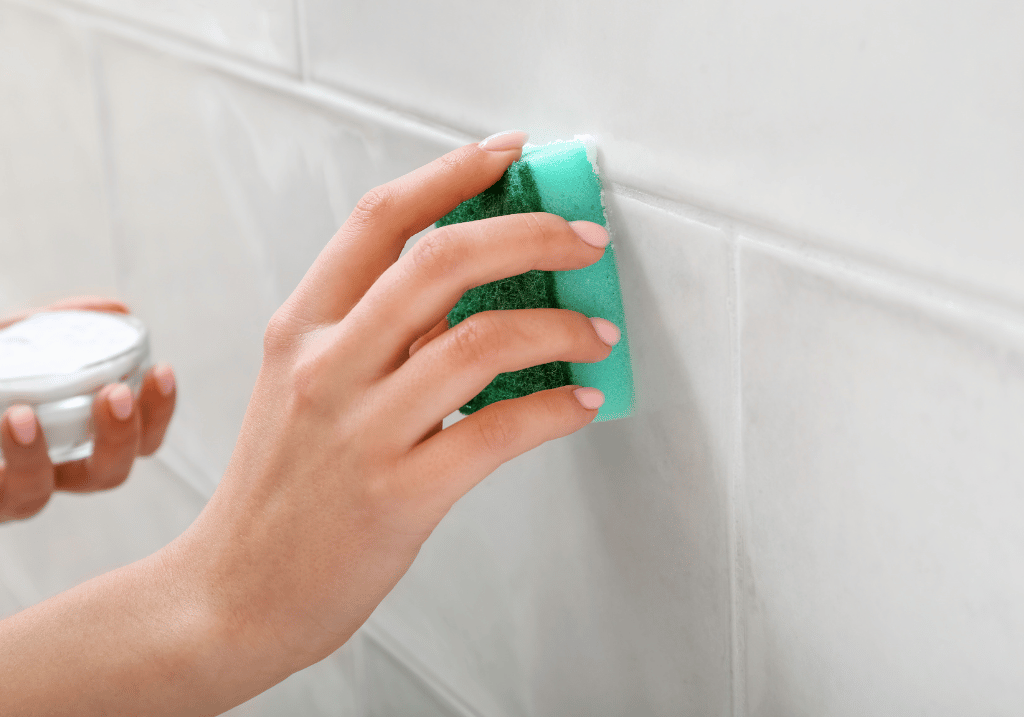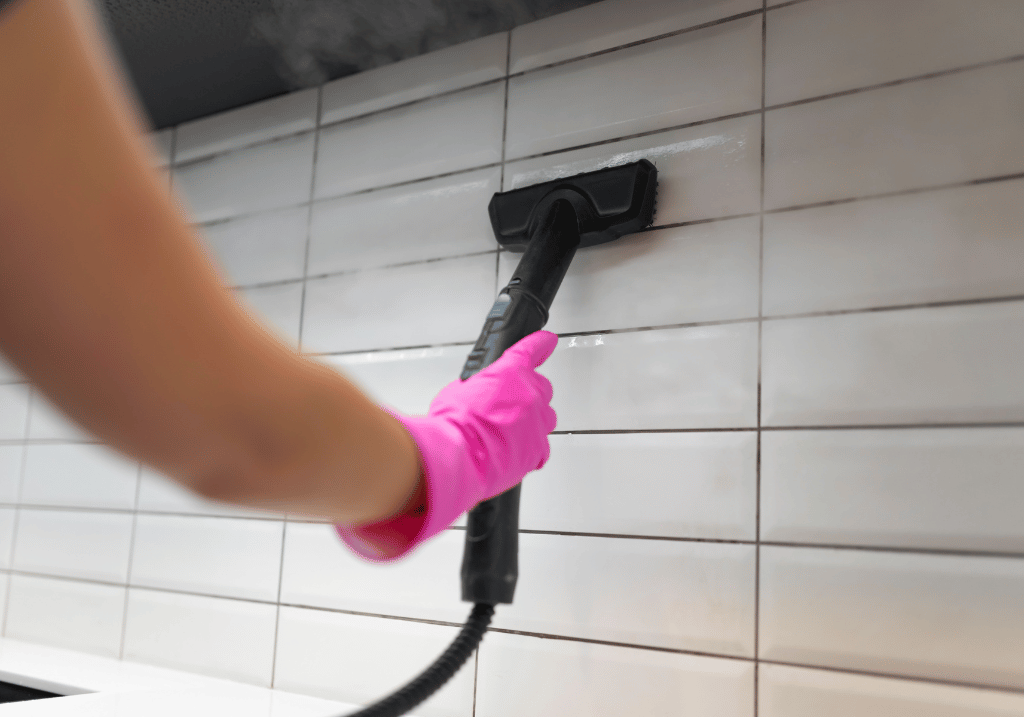Welcome to your ONLY how to guide for one of the peskiest problems in any busy kitchen – how to remove oil stains from your beautiful tiles!
Whether you are a lover of cooking or just someone who takes pride in a spotless home, you’ve faced those annoying oil splatters more than once.
Dealing with these pesky stains can really put a damper on the overall appearance and cleanliness of your kitchen.
But don’t worry!
Discover the ultimate guide to tackling oil stains on kitchen tiles and learn some practical methods that are perfect for DIY enthusiasts in this blog.
At Ceramic City, we’re dedicated to providing you with valuable advice on how to effectively clean and maintain your ceramic and porcelain kitchen tiles.
Get ready to tackle those stains and give them a shiny makeover with ease and confidence!

How to Remove Oil Stains From Kitchen Tiles: Understanding Your Tiles
To effectively remove oil stains from your kitchen, it’s important to have a good understanding of the surface you’re working with.
Each type of ceramic tile has unique characteristics that impact the best approach for treating and removing stains.
Different Varieties of Ceramic Tiles
Glazed Ceramic Tiles: These tiles have a beautiful glossy or matte finish coating, which not only adds a touch of elegance but also provides extra protection against stains. They are not very absorbent, which makes cleaning them quite easy. However, it’s important to note that using harsh chemicals can potentially dull the glaze, so it’s best to opt for gentle cleaning methods.
Unglazed ceramic tiles: Often found in rustic or natural-style kitchens, as they do not have the protective coating that glazed tiles do. Due to their porous nature, stains are absorbed more easily, which calls for immediate and occasionally more assertive cleaning techniques.
Textured ceramic tiles: Can be either glazed or unglazed, and their uneven surface can present an extra challenge. Oil can accumulate in the crevices, requiring a more meticulous cleaning method.
Appearance Matters: Oil stains have a knack for creating unsightly marks that can really throw off the cohesive look of your kitchen flooring or backsplash, taking away from the overall visual appeal of your space.
Over time, oil can seep deeper into the porous layers of unglazed tiles, which may lead to discoloration and weaken the tile structure.
It’s also important not to mix up ceramic tiles with porcelain tiles.
Getting Prepared for the Clean Up
We’ve said it once and we’ll say it over and over again – fail to prepare, prepare to fail!
Whether that is to do with the preparation of the surface, or ensuring you take certain precautions to ensure a safe cleaning process, a good start is half the battle.

So, don’t forget to prioritise safety by wearing protective gear such as gloves and, if needed, protective eyewear, especially when working with chemical cleaners.
Make sure to have proper ventilation in the area too.
Open windows or use a fan to circulate air, which will help minimise the inhalation of fumes from cleaning agents.
Having the correct tools readily available can also greatly simplify and enhance the effectiveness of the task at hand, like some of the below.
- Use soft cloths or sponges for cleaning.
- Gentle scrubbing pads.
- Water container.
- Essential Cleaning Supplies.
- Opt for mild dish soap or a pH-neutral cleaner for a gentle cleaning approach.
- Consider using baking soda or hydrogen peroxide for those tougher stains.
- Consider using commercial tile cleaners for stubborn stains (optional) ask instore for details .

Steps to Take Before Cleaning:
Make sure to clear away any loose debris and gently dab away any excess oil using a paper towel or cloth.
Also, make sure to thoroughly sweep or hoover the area to ensure it’s completely free of any dust or particles.
Step-By-Step: How to Remove Oil Stains from Kitchen Tiles
When it comes to dealing with oil stains, it’s important to act quickly.
This can really help stop the oil from penetrating further into the tiles, so the quicker the better if at all possible.
Blotting the Stain: Get a paper towel or soft cloth to delicately blot or dab the stain.
It’s best to refrain from rubbing, as tempting as it might be, because this can actually cause the oil to spread even more.
Make sure to sweep or hoover the area before cleaning to remove any loose dirt or debris. This will prevent anything from getting rubbed into the tiles during the cleaning process that could scratch it.
Tips for Selecting the Perfect Cleaning Solution: For different types of stains and tiles, you can use various cleaning solutions.
Consider using mild dish soap and water which is perfect for tackling lighter stains and glazed tiles and won’t cause you any extra expense as you will always have these at hand.
Try using a baking soda paste for those tougher stains. This is made using warm water and standard baking soda and mixing it well together until you get a nice paste.
If you’re dealing with stubborn stains on light-colored tiles, you might want to consider using hydrogen peroxide. However, it’s always a good idea to test it on a small, hidden area first to make sure it won’t cause any damage.
Tile cleaners for commercial use: Make sure to check if they are safe to use on ceramic tiles before applying, as they work best on tough stains. So ask an expert or give us a shout.
Step-by-step guide to cleaning:
Here’s a step-by-step guide on how to apply your preferred cleaning solution and how to do the dirty work of cleaning.
Pull up those sleeves and get ready.
Apply the cleaning solution: With your expertise in home DIY and cleaning, you know that using a soft cloth or sponge is the best way to apply the solution to the stained area. Spread the baking soda paste evenly over the stain or whatever option you choose.

Allow the solution to work on the stain for 5-10 minutes.
For baking soda paste, it is recommended to leave it for up to 30 minutes to tackle those stubborn stains.
Effective Scrubbing: Utilise a non-abrasive scrubbing pad or brush to skillfully scrub the stain in a circular motion. Gentle cleaning is recommended to protect the surface of the tile.
Make sure to rinse the area thoroughly with clean water after lifting the stain to ensure there is no residue left from the cleaning solution.
Ensure the area is thoroughly dried by gently wiping it with a clean, dry cloth.
By following these steps, you can ensure that your tiles remain spotless and determine if any additional treatment is necessary for stubborn stains.
Inspect the tile after the area has dried completely.
If the stain continues to be stubborn, you may want to try repeating the process or experimenting with a more powerful cleaning solution.
If you encounter stubborn or deeply ingrained stains, it might be worth seeking professional guidance.
Common Problems and Issues
Occasionally, even with your utmost dedication and elbow grease, certain oil stains can be quite stubborn.
Here are some tips for handling these difficult situations:
- It’s worth repeating the cleaning process if necessary. Sometimes, a second or third application can make all the difference. Having patience is crucial (but hard, we know).
- Enhance Your Cleaning Solution: If regular detergents aren’t effective, you might want to try a more potent cleaning agent. Just remember to always check if it’s safe for your tiles.
- Enhance the Power of Your Baking Soda Paste: When dealing with unglazed tiles, opting for a denser mixture of baking soda and water can yield superior results. Simply apply the solution to the stain, allowing it to sit for about an hour, before gently scrubbing.
Preventing Damage to Tiles: When it comes to removing stains, it’s important to take precautions to protect your tiles too.
- Steer Clear of Harsh Chemicals: Be cautious when using strong acids or alkalis on ceramic tiles, as they can potentially damage the surface, particularly if they are glazed.
- Use only soft scrubbing brushes to avoid scratching the tile surface. Opt for gentler, non-scratchy materials.
- Testing Cleaning Solutions: It’s always a good idea to test new cleaning agents on a small, hidden area of the tile before using them on the entire surface. This way, you can make sure there won’t be any unexpected reactions.
- Other Approaches and When to Utilise Them: There are other ways to tackle tough stains, but it’s important to use them carefully.

Steam cleaning is a fantastic method for tackling tough stains, particularly on textured tiles. It’s a gentle yet highly effective approach.
High-quality cleaning products: Tile-specific cleaners are available, just make sure they are suitable for ceramic tiles and follow the instructions carefully.
Considering hiring professionals: If you’ve exhausted all other options, it may be worth considering bringing in experts who specialise in tile cleaning. They possess the necessary knowledge and tools to effectively tackle stubborn stains without causing any harm to your tiles.
Taking Care and Maintaining Your Tiles
It is important to thoroughly rinse and dry your tiles after cleaning to keep them looking their best and avoid any potential stains.
Ensure a thorough rinsing by using clean water to wash away any remaining cleaning solution residues from the tiles.
For optimal drying, utilise a pristine cloth or towel to carefully dry the tiles.
By following these steps, you can avoid unsightly water spots and thoroughly examine the tile surface for any overlooked areas or lingering stains.
Tips for Regular Maintenance
By performing regular maintenance, you can effectively minimise the occurrence of tough stains and extend the lifespan of your tiles.
Make it a habit to promptly clean up any spills or splatters to avoid stubborn stains.
For a weekly clean-up, it’s best to use a mild detergent and warm water to keep your tiles looking shiny and clean.
Applying a sealant to unglazed tiles every few years can help enhance their stain resistance.

Expert Guidance and Assistance
Knowing when to seek professional help is important.
Occasionally, DIY methods may not suffice, particularly for stubborn or widespread stains. Likewise, if you have painted your tiles, then maybe it isn’t the best solution.
Here are some instances where seeking professional assistance may be beneficial:
- For stubborn or long-standing stains, it may be beneficial to seek professional cleaning services for the most effective solution.
- Cleaning large areas, such as a full kitchen floor, can require quite a bit of effort and time. Experienced cleaners are adept at managing larger spaces with efficiency.
- If you have tiles that are antique, hand-painted, or of a unique make, it’s best to seek the expertise of professional cleaners who can provide specialised care.
For all you DIY heads, if you’re looking to drill a hole in a porcelain tile to hang some decorations, we’ve also got you covered.
Conclusion
Your kitchen is not just a place for cooking; it’s a true testament to the beauty of your home and your dedication to keeping it spotless.
We invite you to try out these suggestions and share your experiences or any extra tips you may have in the comments section below.
If you’re looking for some expert advice, the team at Ceramic City is always here to help you out.
If you need assistance with choosing tiles, learning about care techniques, or finding professional cleaning services, we are here to help. Just give us a call or click on our website or call into one of our stores.
